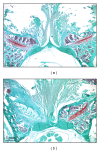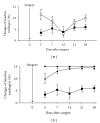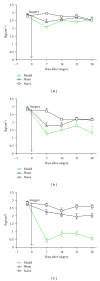Lumbar facet joint compressive injury induces lasting changes in local structure, nociceptive scores, and inflammatory mediators in a novel rat model
- PMID: 22966427
- PMCID: PMC3395270
- DOI: 10.1155/2012/127636
Lumbar facet joint compressive injury induces lasting changes in local structure, nociceptive scores, and inflammatory mediators in a novel rat model
Abstract
Objective. To develop a novel animal model of persisting lumbar facet joint pain. Methods. Sprague Dawley rats were anaesthetized and the right lumbar (L5/L6) facet joint was exposed and compressed to ~1 mm with modified clamps applied for three minutes; sham-operated and naïve animals were used as control groups. After five days, animals were tested for hind-paw sensitivity using von Frey filaments and axial deep tissue sensitivity by algometer on assigned days up to 28 days. Animals were sacrificed at selected times for histological and biochemical analysis. Results. Histological sections revealed site-specific loss of cartilage in model animals only. Tactile hypersensitivity was observed for the ipsi- and contralateral paws lasting 28 days. The threshold at which deep tissue pressure just elicited vocalization was obtained at three lumbar levels; sensitivity at L1 > L3/4 > L6. Biochemical analyses revealed increases in proinflammatory cytokines, especially TNF-α, IL-1α, and IL-1β. Conclusions. These data suggest that compression of a facet joint induces a novel model of local cartilage loss accompanied by increased sensitivity to mechanical stimuli and by increases in inflammatory mediators. This new model may be useful for studies on mechanisms and treatment of lumbar facet joint pain and osteoarthritis.
Figures







Similar articles
-
Development of a novel rat model of lumbar facet joint osteoarthritis induced by persistent compressive injury.Exp Ther Med. 2020 Oct;20(4):3740-3748. doi: 10.3892/etm.2020.9117. Epub 2020 Aug 7. Exp Ther Med. 2020. PMID: 32855725 Free PMC article.
-
Does facet joint inflammation induce radiculopathy?: an investigation using a rat model of lumbar facet joint inflammation.Spine (Phila Pa 1976). 2007 Feb 15;32(4):406-12. doi: 10.1097/01.brs.0000255094.08805.2f. Spine (Phila Pa 1976). 2007. PMID: 17304129
-
Topical high molecular weight hyaluronan reduces radicular pain post laminectomy in a rat model.Spine J. 2005 Sep-Oct;5(5):494-502. doi: 10.1016/j.spinee.2004.12.003. Spine J. 2005. PMID: 16153575
-
Establishment of a bipedal rat model of lumbar facet joint osteoarthritis using intraarticular injection of urinary plasminogen activator.J Orthop Surg Res. 2022 Oct 12;17(1):447. doi: 10.1186/s13018-022-03339-3. J Orthop Surg Res. 2022. PMID: 36224572 Free PMC article.
-
Rat model of lumbar facet joint osteoarthritis associated with facet-mediated mechanical hyperalgesia induced by intra-articular injection of monosodium iodoacetate.J Formos Med Assoc. 2011 Mar;110(3):145-52. doi: 10.1016/S0929-6646(11)60024-7. J Formos Med Assoc. 2011. PMID: 21497277
Cited by
-
Grading Osteoarthritic Changes of the Zygapophyseal Joints from Radiographs: A Reliability Study.J Manipulative Physiol Ther. 2015 Jun;38(5):344-51. doi: 10.1016/j.jmpt.2014.12.009. Epub 2015 Jun 26. J Manipulative Physiol Ther. 2015. PMID: 26118786 Free PMC article.
-
Toll-like receptor involvement in adolescent scoliotic facet joint degeneration.J Cell Mol Med. 2020 Oct;24(19):11355-11365. doi: 10.1111/jcmm.15733. Epub 2020 Aug 27. J Cell Mol Med. 2020. PMID: 32853438 Free PMC article.
-
Development of an Experimental Animal Model for Lower Back Pain by Percutaneous Injury-Induced Lumbar Facet Joint Osteoarthritis.J Cell Physiol. 2015 Nov;230(11):2837-47. doi: 10.1002/jcp.25015. J Cell Physiol. 2015. Retraction in: J Cell Physiol. 2024 Dec;239(12):e31455. doi: 10.1002/jcp.31455. PMID: 25858171 Free PMC article. Retracted.
-
Mechanical Nociceptive Threshold, Tissue Alterations and Horn Growth in Calves after Injection of Isoeugenol or Clove Oil under the Horn Bud.Animals (Basel). 2021 Mar 15;11(3):828. doi: 10.3390/ani11030828. Animals (Basel). 2021. PMID: 33804182 Free PMC article.
-
Development of a novel rat model of lumbar facet joint osteoarthritis induced by persistent compressive injury.Exp Ther Med. 2020 Oct;20(4):3740-3748. doi: 10.3892/etm.2020.9117. Epub 2020 Aug 7. Exp Ther Med. 2020. PMID: 32855725 Free PMC article.
References
-
- Maniadakis N, Gray A. The economic burden of back pain in the UK. Pain. 2000;84(1):95–103. - PubMed
-
- Deyo RA, Weinstein JN. Low back pain. The New England Journal of Medicine. 2001;344(5):363–370. - PubMed
-
- Deyo RA, Mirza SK, Martin BI. Back pain prevalence and visit rates: estimates from U.S. national surveys, 2002. Spine. 2006;31(23):2724–2727. - PubMed
-
- Luo X, Pietrobon R, Sun SX, Liu GG, Hey L. Estimates and patterns of direct health care expenditures among individuals with back pain in the United States. Spine. 2004;29(1):79–86. - PubMed
Grants and funding
LinkOut - more resources
Full Text Sources
